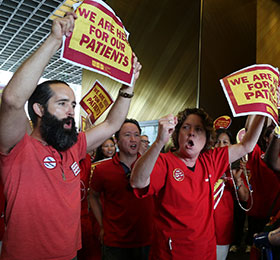Press Release
Is CA Ready to Set Public Safety Protections For Patients in Hospital ‘Observation’ Settings?
Significant Bill Advances in California Assembly
 Legislation that could remedy one of the least-reported problems in U.S. hospitals – the warehousing of patients in “observation status,” which accords fewer protections than other hospital patients are given, and also exposes many patients to economic jeopardy – is nearing the governor’s desk.
Legislation that could remedy one of the least-reported problems in U.S. hospitals – the warehousing of patients in “observation status,” which accords fewer protections than other hospital patients are given, and also exposes many patients to economic jeopardy – is nearing the governor’s desk.
SB 1076, introduced by Sen. Ed Hernandez of West Covina and sponsored by the California Nurses Association/National Nurses United (CNA/NNU), won approval in the Assembly Health Committee on a 14-2 vote Tuesday. It next goes to the Assembly Appropriations Committee in August, the final stop before a vote by the full Assembly. The bill has already passed the State Senate.
Hospitals increasingly use “observation” status – which can mean holding a patient in a hospital bed or even on a gurney in a hallway for long periods of time – specifically to avoid admitting patients in need of more specialized hospital care, nurses charge.
Use of “observation” status, under which a patient can be held for hours or days with less public oversight and fewer protections, puts patients at health and financial risk, nurses say. SB 1076 would extend protections for “observation” patients that are provided to other patients in the hospital setting.
Increasingly, CNA board member David Welch told the Health Committee Tuesday, “patients who ought to be on much higher levels of care being inappropriately placed in observation units in ways that seriously endanger patient safety.”
Hospitals use “observation” classification partly to avoid federal penalties for patients who are frequently re-admitted to hospital care after discharge; the same penalties do not apply for a patient re-admitted after discharge from an observation unit.
Observation status is treated as outpatient, not inpatient care, and is billed by hospitals on an hourly basis rather than on an inpatient daily rate – an economic incentive for hospitals to warehouse patients in observation status to increase their profits.
“As a perverse response to federal incentives, we are seeing a dramatic upward trend in the use of observation – more patients, sicker patients, for longer periods of time,”Welch told the committee. “And, in many places, the creation of specialized observation units where patients look like they are hospitalized, feel like they are hospitalized, receive many of the same treatments as hospitalized patients but – because they are not officially admitted – are under a lower level of regulation and, too often, at a level of staffing not really appropriate to their condition.”
A further problem is that patients held under “observation” for the entire duration of their hospital stay who are then discharged to a nursing home or other long-term care facility do not qualify for the same Medicare reimbursement, and can face mammoth out-of-pocket costs.
Medicare requires patients to be admitted as inpatients for three days before coverage for long-term care will kick in. However, time spent in observation does not count, as observation services are outpatient services.
“Twenty years ago, they would have stayed in the hospital until truly ready to go home. But now they go for a bridge stay in a skilled nursing facility. But Medicare only pays for that stay if the patient has had a three-day stay in an acute hospital – as an admitted inpatient, not on observation status. So it’s all too common for patients to be caught in a bind – told it’s time for them to be discharged, not yet ready to function safely at home, but with no Medicare reimbursement for skilled nursing care,” Welch noted.
Making the problem worse, patients held in “observation” in a hospital are frequently not told of their hospital status.
SB 1076:
- Clarifies that observation units must meet the same staffing standards as emergency rooms.
- Requires hospitals to provide notice to patients that observation services are “outpatient” services and third-party reimbursement may be impacted – and to mark units dedicated for “observation” status as an outpatient area when that unit is not in an ER or part of a normal inpatient unit.
- Directs hospitals to report observation services to the Office of Statewide Health Planning and Development.
- Prohibits hospitals from evading the requirements by disguising “observation” units with a different name.